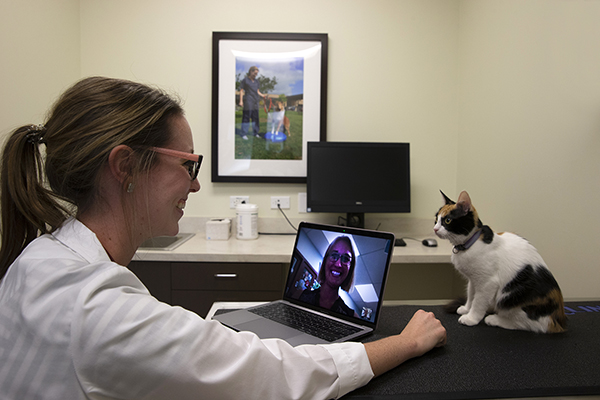Texas A&M CVM Pioneers Use Of Telemedicine To Prioritize Safety, First-Rate Care
Story by Margaret Preigh, CVMBS Communications
The COVID-19 pandemic and associated social distancing measures have severely disrupted the way people are living on a global scale.
But as a leader in innovation and veterinary telemedicine, the Texas A&M College of Veterinary Medicine & Biomedical Sciences’ (CVM) Veterinary Medical Teaching Hospital (VMTH) is uniquely situated to continue providing unparalleled care to its clients and patients, despite current circumstances.

“We have been blessed to have Dean (Eleanor M.) Green, who recognized the important role that telemedicine would play in the veterinary profession, especially as both private practice business models evolve and technology improves,” said Dr. Lori Teller, a CVM clinical associate professor and the first veterinarian hired in academia for the sole purpose of telemedicine. “Clients would much rather get reliable and trustworthy information from their veterinarian via telemedicine than through internet searches.”
Green’s prediction that veterinary telemedicine would play an important role in the future of the veterinary profession is allowing Texas A&M veterinarians to continue serving their clients and patients with little interruption in the current COVID-19 crisis.
“We’ve seen a tremendous increase in the engagement with and the use of telemedicine,” Teller said “With the orders from the government to discontinue elective procedures and only take on urgent and emergent cases, we still need to be able to help our clients and patients with problems before they do become urgent. Virtual care can fill this need.”
The VMTH is currently acting as a trailblazer in implementing this technology to such a large scale.
“To my knowledge, there are no other veterinary colleges that have integrated telemedicine as we have at Texas A&M,” Teller said. “A couple of other institutions have been using it for educational or research purposes but not for direct patient care or consults with our specialists.”
As the expected duration of social distancing measures remains in question, the U.S. Food and Drug Administration (FDA) has recognized the importance of telemedicine, changing their guidelines to allow veterinarians to prescribe certain medications over telehealth appointments.
The VMTH has also been expanding the limits of veterinary telemedicine by broadening the range of services offered through the CVM’s telehealth program, VirtualVet.
“The VirtualVet program has expanded from two services to 10 and now incorporates clinicians from the Small and Large Animal Hospitals so we can meet the needs of diverse types of animals. The number of cases that have been handled has grown exponentially,” Teller said. “This is just another way the VMTH can help provide excellent care to our clients, patients, and the veterinarians who need our assistance in caring for the animals of Texas.”
Pet owners seeking veterinary care through a telehealth appointment need only a reliable internet connection and a device with a camera and microphone. Teller said most smartphones work well for this use.
Currently, only existing clients of the VMTH are eligible for care through the college’s VirtualVet telemedicine program. Other veterinarians are also able to use VirtualVet to consult with one of the hospital’s many experts on cases for which a specialist may be needed.
“Since the VMTH has restricted in-person care to urgent and emergent cases, there are still many patients that need our help,” Teller said. “Some of these may be animals with chronic conditions that we need to maintain regular contact, so that their conditions don’t worsen. We can use a virtual visit to do rechecks, and if necessary, tweak treatment plans.
“Other times, clients may be unsure if the patient needs to come in, so the clinicians can do a virtual visit, assess the patient, and then be prepared for patients that do need to be seen physically,” she said.
Though telemedicine is an excellent tool for ensuring that animals get the care they need in times of disruption, Teller emphasizes that in-person appointments cannot be replaced entirely.
“Virtual care is just one part of veterinary care. There are lots of things we can do with telemedicine, but there are limitations. Sometimes we need to be able to put our hands on the patient, and we need to be able to listen to the heart and lungs, palpate joints and abdominal organs, obtain samples, or get imaging,” she said. “Virtual visits can be wonderful ways to provide care for some things, but not everything.”
If you think your pet requires emergency care, seek veterinary help immediately. Teller advises that pet owners seeking emergency care call their clinic ahead of time to let their veterinarian know they are coming and what the problem appears to be.
“Telemedicine is especially valuable during a pandemic because it can be used to help the veterinarian and the client determine if and when the patient needs to be seen in the hospital, or if the problem can be managed at home, at least for the short term,” Teller said.
“This allows for social distancing to limit exposure of both clients and veterinary staff to an infectious disease while maintaining adequate care for the patient. It also helps conserve PPE (personal protective equipment) and other resources for emergencies and for human health care facilities.”
Owners interested in learning more about telehealth services at the VMTH can visit the VirtualVet portal at https://vetmed.tamu.edu/virtualvet/.
###
For more information about the Texas A&M College of Veterinary Medicine & Biomedical Sciences, please visit our website at vetmed.tamu.edu or join us on Facebook, Instagram, and Twitter.
Contact Information: Jennifer Gauntt, Director of CVM Communications, Texas A&M College of Veterinary Medicine & Biomedical Science; jgauntt@cvm.tamu.edu; 979-862-4216


